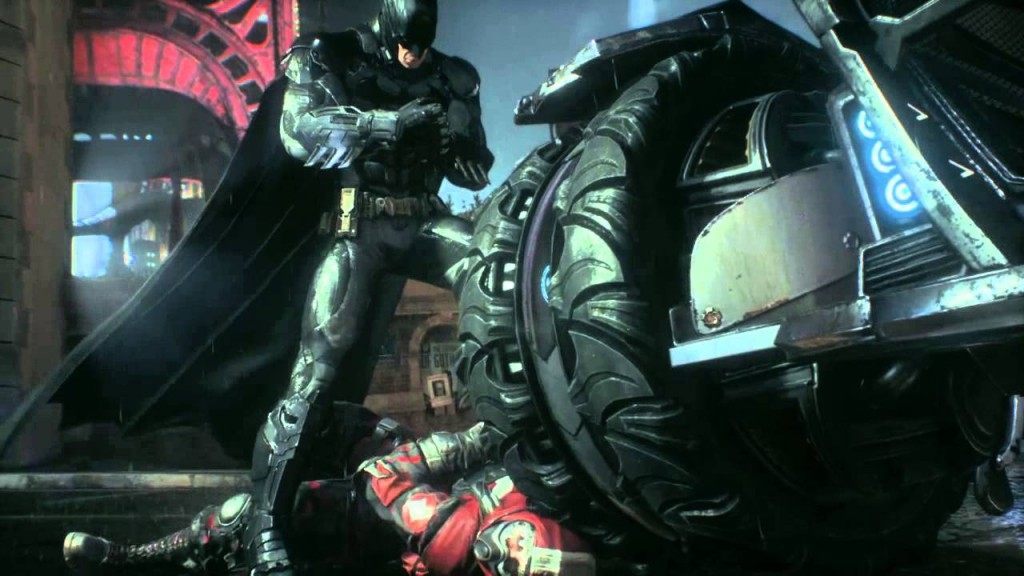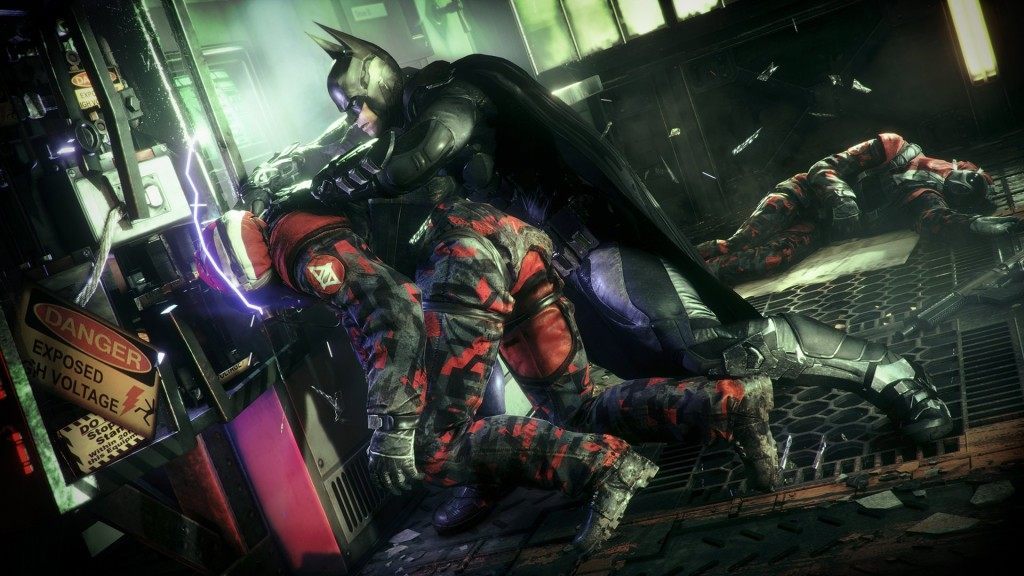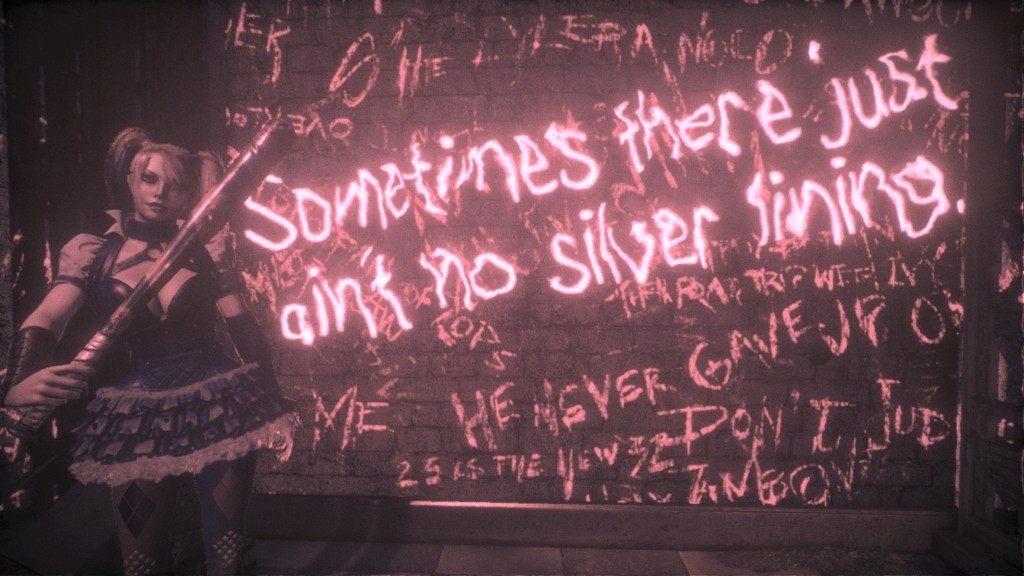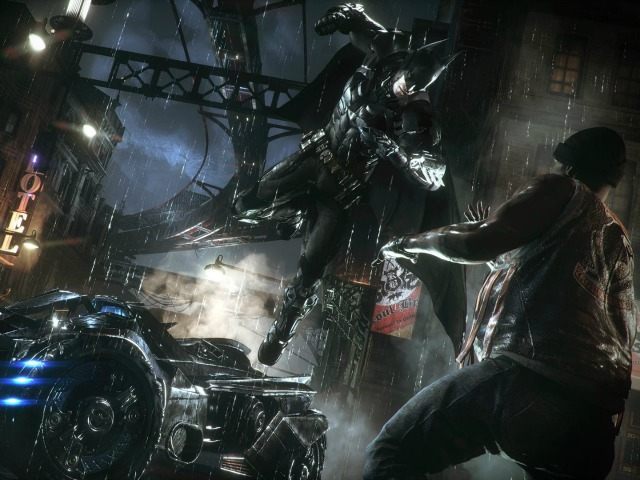Rocksteady Studios’ final installment in their critically-acclaimed Batman series, Batman: Arkham Knight, introduces players to a new dynamic duo of not bat and bird, but bat and car. Since the Batman: Arkham games are of high caliber, this review will compare them not merely to other titles in the market, but specifically to the other two Rocksteady games in the Arkham series to highlight the value added, or lost, by Knight.
With regard to plot, Knight is more consistent than Arkham City. The latter game had a story convoluted by an attempt to incorporate as many villains as possible. While including Ra’s al Ghul, Hugo Strange, Mr. Freeze, and many more increased City’s star power, it did so at the expense of the narrative’s sensibility and the development of a core antagonist. Players were led to believe that one character was the ultimate villain up until a hard-to-predict twist at the end.
Instead, Scarecrow and the Arkham Knight remain the primary enemies throughout Knight. While Scarecrow is the mastermind villain in Knight, Batman spends much more time fighting the Arkham Knight. Indeed, the cryptic Scarecrow sequences from Asylum are missing from Knight up until the end; furthermore, Knight’s John Noble does not sound as monstrous and frightening as the digitally glitched-out voice of Dino Andrade in Asylum.
Knight’s dialogue features many clichés. Death scene lines from Batman’s antagonists were an element of prior Arkham games and can be viewed/listened to below. While lines like Alfred’s, “Your sacrifice will not be in vain,” and the Arkham Knight’s, “I kinda hoped you’d put up more of a fight,” are pretty generic, their inclusion can annoy and infuriate gamers into playing more passionately.
Unquestionably, the biggest addition from City to Knight is the Batmobile, which functions both as the sleek and speedy black beast from the comics, as well as a tank. In order to beat the game, players cannot simply switch between Batman and the Batmobile at will; the Batmobile is vital to completing a large chunk of Knight.
This is not, in and of itself, necessarily a bad thing. It depends on whether players view Arkham Knight as a stand-alone game, or the final chapter in a three-part series. Gamers who are new to the series and expect a more Batman-centric experience will find the reliance on the Batmobile cumbersome. Knight includes various puzzle scenarios in which switches need to be flipped and barriers need to be broken by the Batmobile, hampering the “I work alone” vibe and instead creating a sense of dependency in which the player must figure out ways to bring the Batmobile along from section to section.

With the Batmobile, Batman’s interrogation techniques receive a boost in creativity. (Rocksteady Studios/Warner Bros. Interactive Entertainment)
On the other hand, while implemented too frequently, tank battles are challenging and a nice change of pace. This stems largely from how they force players to multi-task. On the Xbox One version of Knight, gamers must hold the left trigger to keep the Batmobile in tank mode, use the right trigger to attack enemy drones, use the “X” button to fire charged missiles, use the right bumper to defend against enemy projectiles, all while strafing with the “A” button out of the lines of fire that indicate where enemy attacks are incoming. Unlike hand-to-hand combat, there is no simple counter button to render enemy tank attacks useless; gamers must skillfully weave in and out of multiple missile trajectories and are rewarded for good hand-eye coordination.
Fighting against the Cobra variety of the Arkham Knight’s tanks resembles Batman’s Predator challenges, in which he must take out armed thugs. This is because unlike the regular tanks, the Batmobile must take out Cobras from behind, stalking them to charge up a one-hit kill missile. Tank combat with Cobras is more effective than regular Predator gameplay in engaging the player because the Batmobile cannot grapple between gargoyles for easy kills which, let’s face it, is probably how most of us handle enemies with guns. While tank battles deviate from standard Batman gameplay, their demands on the player make their completion intensely satisfying.
Combat in the Batman: Arkham series relies on the freeflow combo system, which rewards gamers’ consistency with increasingly greater amounts of points and cooler-looking attacks. The system is generally engaging; Batman’s inhuman swoops keep players’ eyes trained on the action. Like most elements of the Batman: Arkham series, freeflow combat is leaps beyond systems implemented in other games, but it has changed some in its translation from Arkham Asylum to Arkham Knight.
From Asylum to Knight, Rocksteady has expanded the arsenal of Batman’s adversaries. For the most part, henchmen in the former game went fist-to-fist with the caped crusader, rarely using knives, torches, stun batons, or armored vests. This enabled Batman to plow through baddies, stunning and jumping over the occasional armed thug. Asylum also allowed Batman to take down multiple enemies simultaneously with the multi-batarang and ultra-batclaw, letting skilled gamers chain these maneuvers for high-scoring ground takedowns.

Batman’s new environmental takedowns are cinematic but may disorient gamers as to the position of other enemies. (Rocksteady Studios/Warner Bros. Interactive Entertainment)
With the batarang and batclaw only being used for one enemy at a time in City and Knight, there is not much need to use these gadgets for anything but visual appeal. Strangely enough, aside from quickfire options for these tools and perhaps a couple more, gamers will need to enter a separate pop-up screen to access gadgets instead of simply toggling between them with the direction pad as was available in Asylum and City. One last change will sound nit-picky, but the crackling sound of Batman’s punches and kicks in Asylum were replaced by duller thudding noises in City; this change has been carried onto Knight.
Rocksteady has focused on diversifying Batman’s opponents in Knight. Some wear armored vests, which need to be punched upwards of ten times to overcome. Others wield knives that can only be countered with well-timed input by the player. Still more have weapons that Batman can actually pick up and use. But while all of these elements diversify combat, the need to adapt to each individual henchman can be a bit taxing for gamers who want simply to string out big combos. Holistically, combat gameplay has shifted a bit from rewarding impulse and risk-taking to rewarding problem-solving. While this change may not be noticeable to the casual gamer, long-time Arkham players who set out to conquer the Xbox Live or PlayStation Network high scores will note a difference in tactics used for Knight, when compared with those used in Asylum.
The investigative gameplay in Knight is greatly enhanced. Batman can use his detective mode to reconstruct crime scenes. As players discover new clues, Knight enables them to view more of what transpired, the missing gaps resembling information Batman currently does not know. The Dark Knight must sometimes dissect the crime via video camera feed, requiring players to identify the right reel, navigate to the correct time, and then pinpoint the exact frame in which they have located evidence. Investigative sequences in Knight are immersive, reward logic, and are most definitely not just a gimmick.
Knight also offers Harley Quinn and Red Hood story DLC packs, but compared to the Catwoman and Robin stories of City, these content packs are relatively slim. They can be completed in under half an hour and, unlike in City, the characters cannot be used in a challenge mode by themselves and are only available alongside Nightwing, Catwoman, Robin, and Azrael in brief story segments. This is with the exception of Nightwing, who can pair off with Batman in the challenge mode.
The game’s $40 season pass promises “new content every month for 6 months,” including “new story missions, more supervillains invading Gotham City, new playable Batmobiles, advanced challenge maps, alternative character skins, and new drivable race tracks.” Already, “Batgirl: A Matter of Family” has been announced for release on Tuesday, July 14 for those with the season pass and can be purchased individually for $6.99 on Tuesday, July 21.

Quinn’s Wonderwall: The detective vision of Gotham’s most tortured soul scribbles bloody psychopathy across the walls. (Rocksteady Studios/Warner Bros. Interactive Entertainment)
Arkham Knight has had several performance problems on the PC, leading Warner Bros. to recall it from Steam. While playing it on the Xbox One, my copy froze three times, requiring system reboots each time. But aside from these infrequent issues, the frame-rate did not appear to be compromised during high-speed sequences in the Batmobile or other graphically-intensive areas. Breitbart’s overall rating reflects the Xbox One version of the game, not the PC one.
All in all, Batman: Arkham Knight is a great conclusion to the Arkham trilogy. While it doesn’t fully utilize extra characters like City did with challenge maps, it does have a less convoluted story and maintains a combat system on par with City. Shooting sequences with the Batmobile is a nice change of pace and gratifying, but for the sake of “buyer beware,” the game would have been more aptly titled Batman and Batmobile: Arkham Knight.
Breitbart Score: 87%
Follow Rob Shimshock on Twitter.


COMMENTS
Please let us know if you're having issues with commenting.